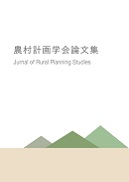最新号
選択された号の論文の17件中1~17を表示しています
- |<
- <
- 1
- >
- >|
論文
-
2025 年5 巻1 号 p. 1-8
発行日: 2025年
公開日: 2025/01/25
PDF形式でダウンロード (671K) -
2025 年5 巻1 号 p. 9-16
発行日: 2025年
公開日: 2025/01/25
PDF形式でダウンロード (1168K) -
2025 年5 巻1 号 p. 17-24
発行日: 2025年
公開日: 2025/03/25
PDF形式でダウンロード (1456K) -
2025 年5 巻1 号 p. 25-33
発行日: 2025年
公開日: 2025/03/25
PDF形式でダウンロード (1292K) -
2025 年5 巻1 号 p. 34-43
発行日: 2025年
公開日: 2025/04/25
PDF形式でダウンロード (1551K) -
2025 年5 巻1 号 p. 44-55
発行日: 2025年
公開日: 2025/04/25
PDF形式でダウンロード (1427K) -
2025 年5 巻1 号 p. 56-65
発行日: 2025年
公開日: 2025/04/25
PDF形式でダウンロード (1576K) -
2025 年5 巻1 号 p. 66-75
発行日: 2025年
公開日: 2025/05/25
PDF形式でダウンロード (495K) -
2025 年5 巻1 号 p. 76-85
発行日: 2025年
公開日: 2025/06/25
PDF形式でダウンロード (1072K) -
2025 年5 巻1 号 p. 86-97
発行日: 2025年
公開日: 2025/07/25
PDF形式でダウンロード (1033K) -
2025 年5 巻1 号 p. 98-109
発行日: 2025年
公開日: 2025/08/25
PDF形式でダウンロード (944K) -
2025 年5 巻1 号 p. 110-119
発行日: 2025年
公開日: 2025/10/25
PDF形式でダウンロード (1709K) -
2025 年5 巻1 号 p. 120-129
発行日: 2025年
公開日: 2025/10/25
PDF形式でダウンロード (1168K) -
2025 年5 巻1 号 p. 130-139
発行日: 2025年
公開日: 2025/10/25
PDF形式でダウンロード (1197K)
報告
-
2025 年5 巻1 号 p. 140-148
発行日: 2025年
公開日: 2025/11/25
PDF形式でダウンロード (1063K) -
2025 年5 巻1 号 p. 149-158
発行日: 2025年
公開日: 2025/12/25
PDF形式でダウンロード (2870K) -
2025 年5 巻1 号 p. 159-166
発行日: 2025年
公開日: 2025/12/25
PDF形式でダウンロード (2462K)
- |<
- <
- 1
- >
- >|
